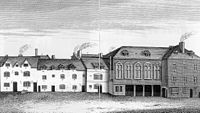Francis Barrington
Sir Francis Barrington, 1st Baronet (ca. 1570 – 3 July 1628)[1] was an English lawyer and politician who sat in the House of Commons in two periods between 1601 and 1628.
Life
Barrington was the eldest son of Sir Thomas Barrington of Barrington Hall, Hatfield Broadoak, Essex (died 1586) and as her second husband Winifred Pole (b. aft. 1521 or in 1525), youngest daughter of the 1st Baron Montagu.[2] He was educated at Cambridge University.[3]
In 1601, Barrington was elected Member of Parliament for Essex.[4] He was knighted on 7 May 1603 on the accession of King James I of England at Theobalds House, Hertfordshire,[5] In 1604 he was re-elected MP for Essex . He was called to the bar by Gray's Inn on 19 March 1605 or 1606.[6] On 29 June 1611, he was made a baronet, of Barrington Hall, in Hatfield Broadoak, County Essex, in the newly erected Baronetage of England.[5]
In 1621 Barrington was elected MP for Essex again. He was re-elected in 1624, 1625, 1626 and 1628 and sat until his death in 1628.
Marriage and issue
Barrington married Joan Cromwell, who died around 1641 with will probated on 14 December 1641, daughter of Sir Henry Cromwell and was therefore uncle by marriage to the future Lord Protector Oliver Cromwell.[7] They had nine children, four sons and five daughters.[2] Barrington was succeeded in the baronetcy by his oldest son Thomas.[2][8]
Notes
- ^ "Leigh Rayment - Baronetage". Retrieved 8 April 2009.
- ^ a b c Burke, John (1841). John Bernhard Burke (ed.). A Genealogical and Heraldic History of the Extinct and Dormant Baronetcies of England, Ireland and Scotland (2nd ed.). London: Scott, Webster, and Geary. p. 43.
- ^ "Baryngton, Francis (BRNN580F)". A Cambridge Alumni Database. University of Cambridge.
- ^ Browne Willis Notitia parliamentaria, or, An history of the counties, cities, and boroughs in England and Wales: ... The whole extracted from mss. and printed evidences 1750 pp176-239
- ^ a b Collins, Arthur (1741). The English Baronetage: Containing a Genealogical and Historical Account of All the English Baronets. Vol. vol. I. London: Thomas Wotton. pp. 71–72.
{{cite book}}:|volume=has extra text (help) - ^ "ThePeerage - Sir Francis Barrington, 1st Bt". Retrieved 4 January 2009.
- ^ Courthope, William (1835). Synopsis of the Extinct Baronetage of England. London: G. Woodfall. p. 16.
- ^ Noble, pp. 46,47
References
- Mark Noble (1784). Memoirs of the Protectorate-house of Cromwell: Deduced from an Early Period, and Continued Down to the Present Time,..., Volume 2, Printed Pearson and Rollason.
- Use dmy dates from November 2012
- 1570s births
- 1628 deaths
- Baronets in the Baronetage of England
- Members of Gray's Inn
- People from Essex
- 16th-century English people
- 17th-century English people
- People of the Tudor period
- English MPs 1601
- English MPs 1604–11
- English MPs 1621–22
- English MPs 1624–25
- English MPs 1625
- English MPs 1626
- English MPs 1628–29
- Baronet stubs
- Parliament of England (pre-1707) MP stubs

